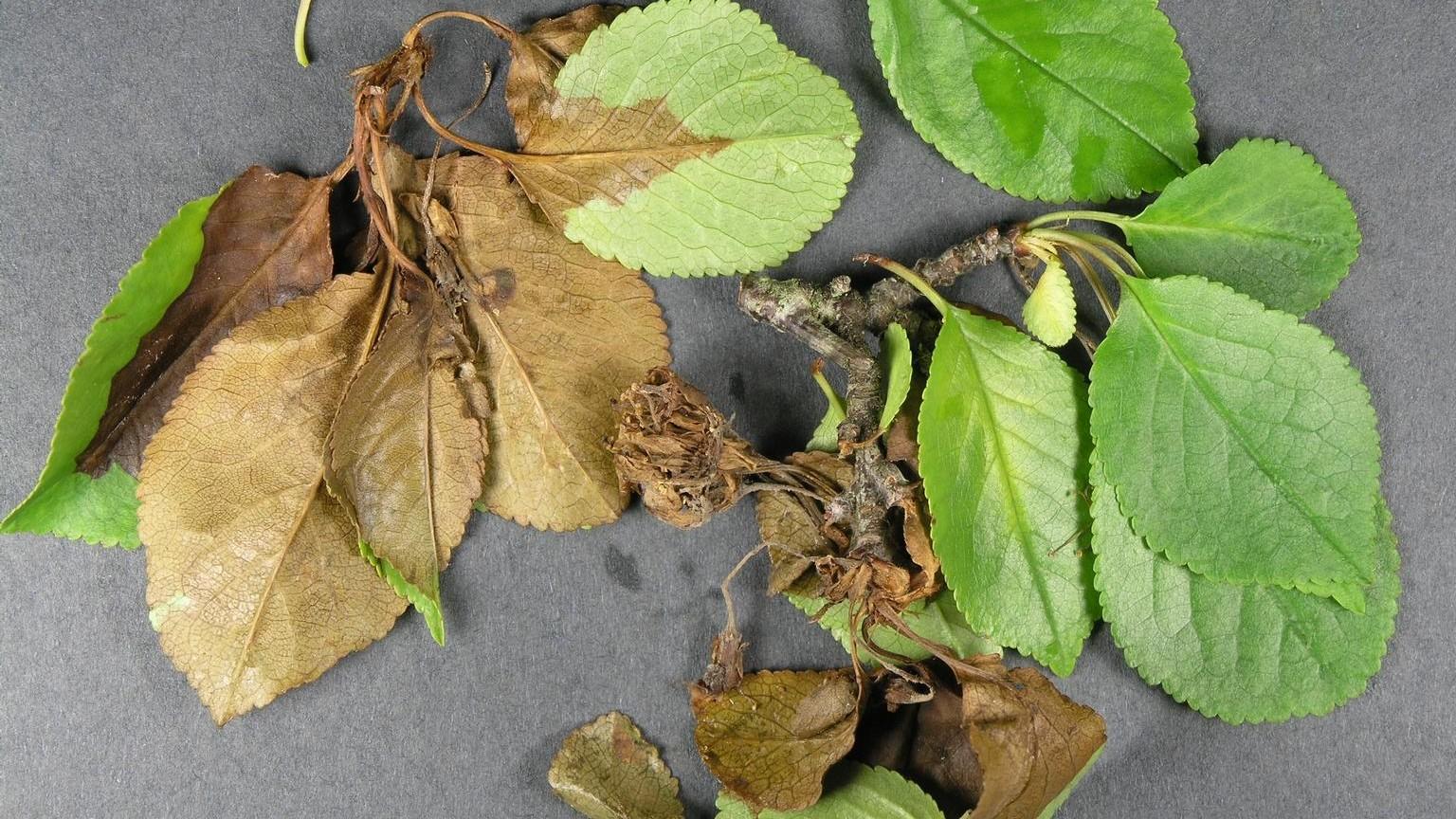Key points
- Brown rot is a fungal infection that attacks flowering cherry trees, especially the cultivar 'Kwansan' later in spring just as the flowers are starting to fade.
- This relatively new disease is really an old orchard disease of stone fruit called brown rot. In Maryland landscapes, this disease is caused by the fungus Monilinia laxa. Brown rot on fruit producing cherries is a common disease found in fruit orchards. Management in the orchard relies on good sanitation and proper timing of protectant fungicides
- The first symptoms often seen are browning and the collapse of the blossoms followed closely by the death of the small twigs.
- The symptoms look like fire blight, but cherries are not susceptible to that disease.

Brown rot symptoms. Photo: David L. Clement, University of Maryland
Disease progression
- If the infected blossoms do not drop off, the fungus can grow through the flower stem (pedicel) and into the twig below.
- Twigs develop elliptical cankers with profuse gumming at the margin between diseased and healthy tissue.
- Leaves on these infected shoots turn brown and wither, but remain attached.
- Sometimes, twigs are girdled and killed.
- During wet weather in May and June, the fungus sporulates (produces spores that spread disease) on the surface of infected twig cankers.
- Cankers enlarge from season to season, and sporulation may continue on large cankers for 4 years or more.
- In rainy weather, the appearance of powdery tufts of brown-gray spores is visible on the outside of infected flowers, infected fruit, or twig surfaces.
Management
- In ornamentals, this disease is a relatively new problem and the control has not been studied extensively.
- Pruning blighted (diseased) shoots back to healthy tissue during dry weather may help, but is difficult if there is a large number of them.
 English
English العربية
العربية Български
Български 简体中文
简体中文 繁體中文
繁體中文 Hrvatski
Hrvatski Čeština
Čeština Dansk
Dansk Nederlands
Nederlands Suomi
Suomi Français
Français Deutsch
Deutsch Ελληνικά
Ελληνικά हिन्दी
हिन्दी Italiano
Italiano 日本語
日本語 한국어
한국어 Norsk bokmål
Norsk bokmål Polski
Polski Português
Português Română
Română Русский
Русский Español
Español Svenska
Svenska Català
Català Filipino
Filipino עִבְרִית
עִבְרִית Bahasa Indonesia
Bahasa Indonesia Latviešu valoda
Latviešu valoda Lietuvių kalba
Lietuvių kalba Српски језик
Српски језик Slovenčina
Slovenčina Slovenščina
Slovenščina Українська
Українська Tiếng Việt
Tiếng Việt Shqip
Shqip Eesti
Eesti Galego
Galego Magyar
Magyar Maltese
Maltese ไทย
ไทย Türkçe
Türkçe فارسی
فارسی Afrikaans
Afrikaans Bahasa Melayu
Bahasa Melayu Kiswahili
Kiswahili Gaeilge
Gaeilge Cymraeg
Cymraeg Беларуская мова
Беларуская мова Íslenska
Íslenska Македонски јазик
Македонски јазик יידיש
יידיש Հայերեն
Հայերեն Azərbaycan dili
Azərbaycan dili Euskara
Euskara ქართული
ქართული Kreyol ayisyen
Kreyol ayisyen اردو
اردو বাংলা
বাংলা Bosanski
Bosanski Cebuano
Cebuano Esperanto
Esperanto ગુજરાતી
ગુજરાતી Harshen Hausa
Harshen Hausa Hmong
Hmong Igbo
Igbo Basa Jawa
Basa Jawa ಕನ್ನಡ
ಕನ್ನಡ ភាសាខ្មែរ
ភាសាខ្មែរ ພາສາລາວ
ພາສາລາວ Latin
Latin Te Reo Māori
Te Reo Māori मराठी
मराठी Монгол
Монгол नेपाली
नेपाली ਪੰਜਾਬੀ
ਪੰਜਾਬੀ Afsoomaali
Afsoomaali தமிழ்
தமிழ் తెలుగు
తెలుగు Yorùbá
Yorùbá Zulu
Zulu ဗမာစာ
ဗမာစာ Chichewa
Chichewa Қазақ тілі
Қазақ тілі Malagasy
Malagasy മലയാളം
മലയാളം සිංහල
සිංහල Sesotho
Sesotho Basa Sunda
Basa Sunda Тоҷикӣ
Тоҷикӣ O‘zbekcha
O‘zbekcha አማርኛ
አማርኛ Corsu
Corsu Ōlelo Hawaiʻi
Ōlelo Hawaiʻi كوردی
كوردی Кыргызча
Кыргызча Lëtzebuergesch
Lëtzebuergesch پښتو
پښتو Samoan
Samoan Gàidhlig
Gàidhlig Shona
Shona سنڌي
سنڌي Frysk
Frysk isiXhosa
isiXhosa